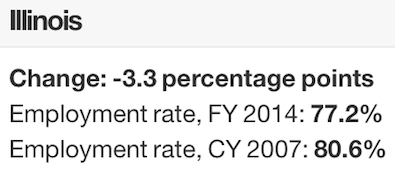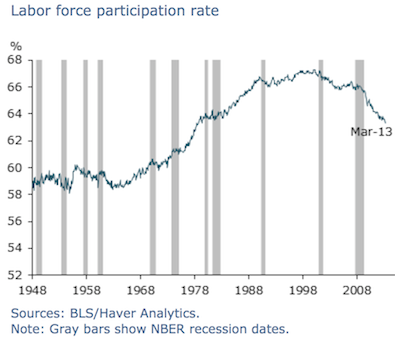* From the Pew Charitable Trusts…
Employment rates for 25- to 54-year-olds were lower in 29 states in fiscal year 2014 than in 2007, before the Great Recession. In 2007, 79.9 percent of people ages 25 to 54 in the United States had a job. In the 12 months ending June 2014, five years after the recession ended, only 76.2 percent of people in that age group were working.
* Methodology…
Pew weighted data from the Current Population Survey using values provided by the U.S. Bureau of Labor Statistics. These data were used to calculate the total number of civilian, noninstitutionalized 25- to 54-year-olds in each state and in the nation. Pew then calculated the average percentage of people who were employed in each of those populations. These calculations were done for 2007 (January through December) and fiscal 2014 (July 2013 through June 2014). Pew used these values to calculate the percentage-point change from 2007 to fiscal 2014. Significance tests were performed to determine which changes were statistically significant at a 0.05 level.
The top five states, in order were Vermont, Nebraska, Minnesota, Massachusetts and Alaska.
* US average…

* Illinois actually did a little bit better than the national average…

* Meanwhile, we already discussed this hyperbolic statement by Bruce Rauner’s campaign today…
“Tens of thousands of people are giving up looking for work because of Pat Quinn’s failed policies,” Rauner said. “More than 63,000 people have given up hope on finding a job since April and Pat Quinn is out celebrating – it’s downright offensive to struggling families around Illinois.”
* So, I went looking through various Federal Reserve Board publications to see what their explanation was. Let’s start with this chart from the San Francisco Fed…

* James Bullard, President and CEO, Federal Reserve Bank of St. Louis, explained the history back in February…
If you know only one aspect of the data on labor force participation, it should be this: Labor force participation used to be relatively low, it rose during the 1970s, 1980s and 1990s, peaking in 2000, and it has generally been declining since 2000. […]
After about three decades of trending up, the labor force participation rate peaked in the first half of 2000 at 67.3 percent. The rate of increase was slower in the 1990s than it was in the 1970s or 1980s. The peak was more than 8 percentage points higher than the average level during 1948 - 1966. Many of the studies of labor force participation during this period focused on the increasing participation rates of women. However, whatever effects came from that source, or any other source, the labor force participation rate could not continue to increase forever. Households are making choice s about how much labor to supply given current wages and work environments, and women newly joining the labor force would find the right level of participation and stop there.
Since 2000, the labor force participation rate has generally been declining. The pace of decline was particularly sharp during the recession of 2007 - 2009, but the participation rate also declined steadily in the early 2000s and since the end of the recession in mid - 2009. […]
According to BLS projections, more than 70 percent of this decline is due to pure demographic factors; that is, changes in population shares by age groups, assuming unchanged participation rates for each group.
* By Willem Van Zandweghe at the KC Fed…
The primary factor behind this decline is the rising share of older workers in the population as the baby-boom generation ages and life expectancies increase. The rising share of older workers pulls down the LFPR because older workers have lower participation rates than prime-age workers. A second factor behind the gradual decline of the LFPR has been a steady reduction in labor force participation among young people over the last decade, resulting in large part from rising school enrollment
* Shigeru Fujita, of the Federal Reserve Bank of Philadelphia, February 6, 2014…
Nonparticipation due to retirement did not rise until the end of the Great Recession but started to increase significantly in 2010. Since the start of 2012, it has been the most important contributor to the increase in the overall nonparticipation rate.
* Washington Post…
Americans over the age of 65 are much less likely to work than prime-age Americans. And since that subset of Americans is swelling, that drives the labor-force participation rate down. Note that this is happening even though older Americans are staying on the job for longer than they did during the 1990s.
* And the Chicago Fed predicted more declines in the labor force through 2020…
Roughly two-thirds of the decline is due to the aging of the labor force (in particular, baby boomer retirements)
…Adding… Last year, when Illinois’ unemployment rate was really high, Bruce Rauner focused heavily on the rate. Now, of course, he’s saying the rate doesn’t matter. A few quotes sent over by Gov. Quinn’s campaign…
“Unemployment is awful. But in Danville, Decatur, and Rockford and other places, unemployment is well over 10%. These places share one common need: Jobs - and we need leaders who have experience in creating them.” -Rauner FB Post, 3/10/2013
“Under Pat Quinn we have become hostile to business and have moved up to one of the highest unemployment rates in America. We use to be leading the nation in economic growth and now we are at the bottom.” -WLDS, 8/15/14
“Rauner told the crowd he wants to bring his success in business to Springfield. In the process, his focus is to achieve results that will point to Illinois having the best schools and “the lowest unemployment in the country as opposed to the third highest” -SIOR-AIRE Meeting, 5/27/14
…Adding More… Greg Hinz…
For instance, the share of Illinois adults in the workforce dropped a whopping 4.1 percentage points in the past six years, slipping to 64.7 percent from 66.8 percent. Not good. But in Michigan and Ohio, the slippage was a statistically indistinguishable 3.9 percent each. And their current participation rates remain well under ours, at 60.4 percent and 62.8 percent, specifically.




















- wordslinger - Tuesday, Aug 19, 14 @ 12:29 pm:
Who knew the Baby Boomers would retire? Just everybody, forever.
- Nearly Normal - Tuesday, Aug 19, 14 @ 12:35 pm:
This Baby Boomer retired. Yep, my fault.
- Abe the Babe - Tuesday, Aug 19, 14 @ 12:36 pm:
Rich, something must be wrong with your information. I’ve been told consistently over the past 4 years that obamacare was the primary driver of job loss.
Are you saying its only #2?
- Formerly Known As... - Tuesday, Aug 19, 14 @ 12:43 pm:
As I pointed out in another post about an hour ago, it is far too early to know for certain. There has clearly been a sudden and statistically significant decrease in our labor force taking place during recent months. This decrease also appears to be historically large for our state.
Data and reports on this exist from the BLS, Census and many others, but a fair bit of it conflicts with each other and very little appears to be Illinois-specific. Every time one report chalks it up to retirements and aging, another report attributes the most likely cause to economic factors and discouraged workers.
For example, the Chicago Fed estimated that retirements account for only about 25% of the drop in labor force participation while the rest are mostly discouraged workers. But a Barclays economist estimated that discouraged workers account for only about 35% of the drop in labor force participation while the rest are mostly retirees, the majority of whom are baby boomers. I wish we knew, but it appears too early to know with certainty since there is so much conflicting data.
- VM - Tuesday, Aug 19, 14 @ 12:46 pm:
I should add that Illinois’s labor participation rate is a bit (not much, but a bit) higher than the average of the states at 60.3 of the non-institutionalized adult population — worse than Wisconsin (63.9%), better than Indiana (59.5%) and Michigan (55.8%).
It’s a complicated recovery. Personally, I believe that the bigger problems are national macroeconomic problems (decrease in aggregate demand, consumer debt, and stagnant wages) combined with the argument made by Picketty that capital right now earns far more in rent than the rate of growth (r>g). But we’re beyond the scope of the blog now.
- Anonymous - Tuesday, Aug 19, 14 @ 12:49 pm:
Mr. Formerly Known As,
Yes, much more data needs to be analyzed in order to pin point why the labor participation rate is declining. But, it is a trend that predates Democrats being in control of the Governor’s Mansion. But that’s the point isn’t it? Rauner is blaming this on Quinn when clearly there is something bigger going on here. So, again, Rauner is either dishonest, or ignorant of this important economic issue.
- Louis G Atsaves - Tuesday, Aug 19, 14 @ 1:12 pm:
Comparing numbers going back to 1948? When two income families were more of a rarity than today?
Fun with numbers, indeed. All these studies. All these surveys. Declining number of workers in our economy is good?
Down is Up. Up is down. Wealth is poverty. Poverty is wealth. Reduced unemployment rates in the face of more dropping out of the workforce. Right now all I’m reading from all this number crunching is a bunch of circular logic that isn’t resolving anything.
- Rich Miller - Tuesday, Aug 19, 14 @ 1:14 pm:
=== Declining number of workers in our economy is good?===
Who said that?
Calm down.
The numbers are the numbers, and they appear to show that much of his is based on retirements.
- Grandson of Man - Tuesday, Aug 19, 14 @ 2:01 pm:
Thanks so much, Rich, for digging out these numbers and providing us with this useful info.
I figured that part of the decline in workforce participation is that people are of retirement age. Someone in my family plans on retiring early and perhaps taking a part-time job.
“obamacare was the primary driver of job loss”
There’s a school of thought out there that says having Obamacare may benefit people who are older workers and nearing retirement age, or people who are looking for satisfactory work and don’t want to be tied down to a job they don’t like because it offers health insurance–so called “job lock.”
- wordslinger - Tuesday, Aug 19, 14 @ 2:10 pm:
–”We use to be leading the nation in economic growth and now we are at the bottom.”–
When was that, professor? Because the national tilt to the Sunbelt and West has been going on for about 70 years. Who knew Quinn had been around that long?
- Andrew Szakmary - Tuesday, Aug 19, 14 @ 2:12 pm:
I do not see how demographic factors like retirement of the baby boomers, increasing numbers of young people going to college/grad school, etc. can explain a 3.7 percentage point decline in the national employment rate of 25-54 year olds. People in this age group generally do not retire or go to school full time (at least voluntarily).
My best guess is that the decline in labor force participation stems from the stagnation/decline in wages. If the best job you can get pays $10 an hour or less and you have children at home, foregoing paid employment outside the home (and the resulting child care expenses) may be a perfectly rational decision.
- Responsa - Tuesday, Aug 19, 14 @ 2:18 pm:
In truth, sheer numbers never tell us all we need to know in order to understand patterns. What I’d like to know is how the employment participation rate of recent high school and college grads tracks over a 20 year period. With respect to the boomer retirements, to get the true picture it is necessary to know how many of these “retirements” were much much earlier than people had planned or wanted, and how many were forced to take early social security at a lesser value because of the poor job prospects for people their age to work in this economy. Further, there are some numbers of younger boomer retirees who started small businesses or bought franchises in hopes of maintaining an income stream–a second career. The economy has not been kind to a great many of these businesses.
- Andrew Szakmary - Tuesday, Aug 19, 14 @ 2:19 pm:
Another, related issue is that many more people are on disability rolls than before the recession. Some of this is no doubt due to the aging of the population, but I suspect that the remainder of the increase is due to disability payments becoming more attractive as wages have declined.
- Formerly Known As... - Tuesday, Aug 19, 14 @ 2:26 pm:
Mr., Ms. or Mrs. Anonymous,
This trend predates Democratic control of the mansion. This sudden acceleration in that trend does not.
As has been discussed at length here, both Rauner and Quinn “cherry-pick” numbers. Quinn polishes up the jobs numbers. Rauner highlights the labor participation rate. If that makes one guilty of dishonesty or ignorance, then they both are.
And as commenters such as wordslinger have pointed out, the governor never has as much to do with job creation as some like to think. While wordslinger and I disagree on just how much a role government plays in that, many of us agree that governors get too much credit for good economic news and too much blame for bad economic news. I do not blame Quinn or defend Rauner for any of this, but I would like to understand why we suddenly have so many more people dropping out of the labor pool than finding jobs.
Respectfully,
Mr., Ms. or Mrs. Formerly Known As…
- Yellow Dog Democrat - Tuesday, Aug 19, 14 @ 2:32 pm:
Andrew:
Sorry you can’t see it, but thanks for your best guess.
All of those economists and demographers with their college degrees must be wrong.
- Rod - Tuesday, Aug 19, 14 @ 2:34 pm:
There is also an increase in the percentage of the population across the nation on Social Security Disability Insurance (SSDI) and on Federal Supplemental Security Income (SSI). There are several major contributing reasons for this increase, first more children with significant disabilities are surviving birth due to advances in medicine. Second more working adults who are significantly injured either at work or outside of work are surviving these injuries and living with significant disabilities. Third there is also a significant increase in mental illness in the United States. Mental illness has been on the rise over the past few decades. Between 1987 and 2007, the number of people with mental disorders that qualify for Supplemental Security Income or Social Security Disability Insurance increased about two and a half times.
- Skeptic - Tuesday, Aug 19, 14 @ 2:44 pm:
=== Declining number of workers in our economy is good?===
=Who said that?=
(Actually I suggested that hypothesis yesterday.)
- CapnCrunch - Tuesday, Aug 19, 14 @ 3:17 pm:
“The numbers are the numbers, and they appear to show that much of his is based on retirements.”
I think that is correct. Last year, for example, 49 million of the 90 million people not in the labor force were over the age of 55. However, the Fed stats concern the LFPR which includes everybody over the age of 16 while the Pew research concerns a different cohort( 25-54 ). These folks are in their prime years. Their research says that about 1 in 4 working age Americans is not in the labor force. According to BLS data, last year about 24 million people in this group were not in the labor force and 21 million of them did not want a job. If they are early Boomer retirees, they have certainly been successful. Are they independently wealthy? If not, how are they being supported?
- Andrew Szakmary - Tuesday, Aug 19, 14 @ 3:59 pm:
Yellow Dog,
I have a PhD in Financial Economics and yes, I am sometimes wrong. But I don’t think I’m wrong in saying that demographic factors are unlikely to be the explanation for the precipitous decline in labor force participation rates among the 25-54 cohort. Most of the economist comments Rich included pertain to the overall decline (in which demographics do play a part), not specifically to the decline in the 25-54 cohort.
- Formerly Known As... - Tuesday, Aug 19, 14 @ 4:13 pm:
== in which demographics do play a part ==
iirc, Illinois also has one of the younger median ages in the nation.
I am curious to learn more about what the root cause of this labor force decline is specifically in Illinois, but unfortunately that will take time and many more studies for a conclusive answer.
- Enviros-Anon - Tuesday, Aug 19, 14 @ 4:34 pm:
There is an increasing number of foreign workers with H1-b work visas who are replacing American workers resulting in higher unemployment and underemployment of American workers.
http://www.computerworld.com/s/article/9249174/Readers_rant_about_IT_worker_who_trained_H1_B_replacement_
- Mason born - Tuesday, Aug 19, 14 @ 4:58 pm:
To be blunt why it’s happening isn’t as important as the effects will be. Less people working as a percentage means less folks paying income tax while the same number of citizens requiring vital services and the money to provide them. To me either a smaller percentage of workers will have to pay more or more folks will have to accept less. Neither option is politically popular.
- Enviros-Anon - Tuesday, Aug 19, 14 @ 5:04 pm:
Here is more evidence that H-1b work visas are making it more difficult for workers to find jobs:
“Irwin Stelzer, writing for the Weekly Standard, and Robert Samuelson, columnist for the Washington Post, show how, despite high unemployment levels for Americans in their 40s, 50s, and 60s, corporate elites would rather import cheap foreign labor to systematically displace these available American workers, who bring tremendous experience, insight, and wisdom to the table.”
http://www.cis.org/edwards/H1B-Visa-Leaves-Americans-on-the-Sidelines
- CapnCrunch - Tuesday, Aug 19, 14 @ 5:21 pm:
“To be blunt why it’s happening isn’t as important as the effects will be…….”
You are absolutely correct about the effects but aren’t you curious about why 1 in 4 working age Americans doesn’t have a job and doesn’t want one?
- Mason born - Tuesday, Aug 19, 14 @ 5:43 pm:
Capn
I am absolutely curious in the same way i am curious about this awesome summer and horid winter we had. The cause of the winter is immaterial when I have 18″ of snow to move I simply put more diesel in the deere.
Remember we are talking about the choices of 63k individuals going through 63k different scenarios. I lack the omniscience to know the decisions of that many people I have enough trouble figuring out what my wife is going to think of her birthday present.
The economy of the u.s. and by extension IL is a massive complex beast made up of individuals trying to manage their own micro economies. If the economy was simple we’d have thousands of Warren Buffets.
- ZC - Tuesday, Aug 19, 14 @ 7:06 pm:
Something else here operating at the margins of these unemployment statistics is as noted the median age of the population.
If your state is becoming a retirement home and is not attracting any young job seekers, then lo and behold your unemployment rate (drawn from those actively seeking work) is going to be really low. But I wouldn’t call that a healthy economic state of affairs. Illinois is still at least attracting a decent influx of under-thirty workers seeking employment from around the Midwest, and we have Chicago in no small part to thank for that.
I’m not saying that effect is enough to counterbalance Illinois’ unemployment disparities versus other states - I’m no PhD in economics - but it’s a factor on the margins.